Reclamation and Management of Alkali Soils
-
Chemical amendment (gypsum) based technologies for reclamation of alkali soils has been developed and popularized.
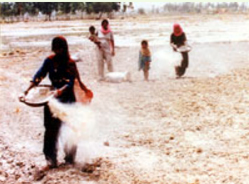 It has been handed over to State Land Reclamation Corporations for implementation. Around 1.8 lakh ha area has so far been reclaimed (Photo top)
It has been handed over to State Land Reclamation Corporations for implementation. Around 1.8 lakh ha area has so far been reclaimed (Photo top)
-
Alkali land reclamation activity in the last 40 years generated one time employment of about 25 million man-days in the first year of reclamation. In addition, it now generates an annual employment of 75 million man-days each year for rice-wheat cultivation on the reclaimed lands
-
The technology is economically viable with Benefit-Cost Ratio (BCR) of 1.43 and Internal Rate of Return (IRR) of 25% (Photo bottom)

-
Currently salt tolerant varieties with reduced dose of gypsum (25% against 50% of GR) and alternate locally available and/or industrial byproducts such as phospho-gypsum and distillery spent wash are being advocated to reclaim alkali lands
|
On an average, 45,000 ha alkali land is being reclaimed annually since the inception of the institute making a total of about 1.8 million ha, contributing 12-15 million tones of paddy and wheat annually. It has ensured house hold food security and changed the socio-economic profile of more than 9 million people residing in rural India directly. Besides, it has benefited large number of landless labourers indirectly by generating employment halting migration from rural to urban centers.
|
Management of Waterlogged Saline Soils
-
Subsurface drainage technology consists of a network of concrete or PVC pipes covered with gravel or synthetic filter,
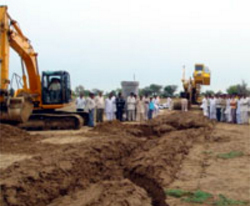 installed manually or mechanically at a design spacing and depth below soil surface to control water table and help in the leaching process
installed manually or mechanically at a design spacing and depth below soil surface to control water table and help in the leaching process -
The technology developed initially for Haryana, has been widely adopted and replicated in Rajasthan, Gujarat, Punjab, Andhra Pradesh, Madhya Pradesh, Maharashtra and Karnataka (Photo top)
-
Around 50,000 ha waterlogged saline soils have been reclaimed in different states of India, where the cropping intensity has increased by 25 to more than 100% and crop yields by up to 45% (paddy),
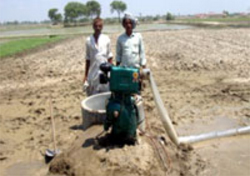 111% (wheat) and 215% (cotton). (Photo bottom)
111% (wheat) and 215% (cotton). (Photo bottom)
-
The technology generated around 128 man-days additional employment per ha per annum. The technology has a Benefit-Cost Ratio (BCR) of 1.36 and Internal Rate of Return (IRR) of 20%
|
As a follow up of Indo-Dutch Network Project, the institute was associated in HOPP projects and this collaboration is continuing for large scale drainage projects in various districts of the state.
|
Management of Poor Quality Waters
-
-
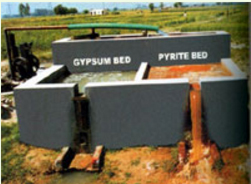 Increasing urbanization and industrialization have created huge pressure on the good quality groundwater resources, forcing the use of poor quality waters for irrigation in agriculture. Location specific technologies have been developed based on soil management irrigation water management, rainwater management and chemical amendment etc.
Increasing urbanization and industrialization have created huge pressure on the good quality groundwater resources, forcing the use of poor quality waters for irrigation in agriculture. Location specific technologies have been developed based on soil management irrigation water management, rainwater management and chemical amendment etc. -
For the use of saline/sodic waters, common guidelines based on soil, climate and crop characterization have been developed (Photo top)
-
 Increased utilization of saline groundwater helps prevent development of waterlogging and soil salinization (Photo bottom). It also enhances employment opportunities by increasing labour requirement for crop production activities with saline irrigation on lands those were otherwise kept fallow. Estimates in this regard are about 55 million man-days of employment per year
Increased utilization of saline groundwater helps prevent development of waterlogging and soil salinization (Photo bottom). It also enhances employment opportunities by increasing labour requirement for crop production activities with saline irrigation on lands those were otherwise kept fallow. Estimates in this regard are about 55 million man-days of employment per year
-
|
Out of 13.2 M ha groundwaters use, about 3.2 M ha is through exploitation of poor quality waters. Rough estimates of its contributions in food grain production are expected to the tune of Rs. 800 crores in addition to generation of rural employment and multifarious environmental benefits.
|
Crop Improvement for Salinity, Alkalinity and Waterlogging Stresses
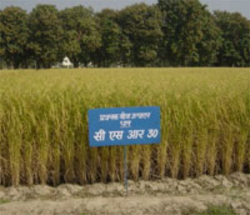
Sustained breeding efforts at CSSRI have resulted into the release of twelve varieties of rice (CSR 10, CSR 13, CSR 23, CSR 27, CSR 30, CSR 36, CSR 43, CSR 46, CSR 49, CSR 52, CSR 56 and CSR 60), five varieties of wheat (KRL 1-4, KRL 19, KRL 210, KRL 213 and KRL 283), five varieties of Indian mustard (CS 52, CS 54, CS 56, CS 58 and CS 60) and one variety of gram (Karnal Chana 1) by Central Varietal Release Committee for salt affected areas of the country.
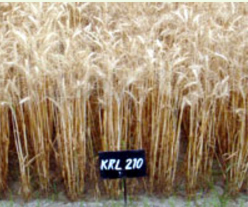
The popularity of these varieties can be gauged from the fact that during the last five years (2014-2019), 34 t breeder seed of rice, 29 t breeder seed of wheat and 2.3 t breeder seed of mustard varieties have been distributed to different agencies
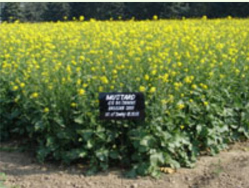
- Two genotypes of Dhaincha (CSD 123 and CSD 137) giving high foliage biomass at 45-50 days after sowing have been registered with NBPGR
Alternate Land Use Systems
-
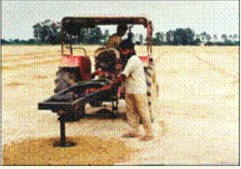 For the reclamation of highly deteriorated, mainly community lands, institute has developed and standardized an augur hole technology for raising forest and fruit tree plantation in salt affected soils (Photo top)
For the reclamation of highly deteriorated, mainly community lands, institute has developed and standardized an augur hole technology for raising forest and fruit tree plantation in salt affected soils (Photo top) -
Plants tolerance to alkali conditions has been evaluated and listed in order of their tolerance
-
Comparison of different agro-forestry models for reclamation revealed that the B:C ratio for alkali soil reclamation following chemical amendment approach was 1.3 to 1.4, 1.25 for subsurface drainage technology and 1.60 for afforestation with different agro-forestry models (Photo bottom)
-
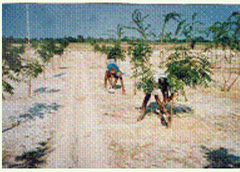 This technology has contributed significantly in augmenting fuel wood and forage needs of landless labourers and small farmers; increased forest cover helps sequestering carbon to moderate the impact of climate change
This technology has contributed significantly in augmenting fuel wood and forage needs of landless labourers and small farmers; increased forest cover helps sequestering carbon to moderate the impact of climate change
|
Following this technology, about 60,000 ha land has been reclaimed through tree plantation, social forestry projects of different State Govt, afforestration of village Panchayat lands, Govt. and absentee lands.
|
Bio-Saline Agriculture
Irrigation with saline waters should aim to create favourable niches for the better establishment of saplings and also eliminate salinity build-up in the soil. Besides arable cropping, saline waters could be used to grow forest and horticultural plantations and medicinal, aromatic, spices and halophytic crops.
-
 Subsurface planting and furrow irrigation system (SPFIM) has been developed to grow forest plantation ( Photo top) and fruit trees. Amongst the fruit trees Feronia limonia, Ziziphus mauritiana, Carissa carandus, Emblica officinalis and Aegle marmelos could be irrigated with saline water up to EC 10 dS m-1 and intercropped in wider spaces between rows (5 m) with crops such as cluster bean and barley
Subsurface planting and furrow irrigation system (SPFIM) has been developed to grow forest plantation ( Photo top) and fruit trees. Amongst the fruit trees Feronia limonia, Ziziphus mauritiana, Carissa carandus, Emblica officinalis and Aegle marmelos could be irrigated with saline water up to EC 10 dS m-1 and intercropped in wider spaces between rows (5 m) with crops such as cluster bean and barley  applying one or two irrigations ( Photo middle)
applying one or two irrigations ( Photo middle) -
Grasses such as Panicum laevifolium and P. maximum could be grown with saline water (EC 10 dS m-1)
-
Ornamental flowers such as Chrysanthemum, Calendula and Matricaria can successfully be cultivated with saline water of EC up to 5 dS m-1.
-
The aromatic grasses such as vetiver, lemon grass and palmarosa, could be cultivated with saline water of EC 8.5 dS m-1
-
 Medicinal crop, psyllium (Plantago ovata) could be cultivated with saline water (EC 8.5 dS m-1) (Photo bottom). Other crops that could be grown are Aloe barbadensis,Ocimum sanctum,Cassia angustifolia and Lepidium sativum.
Medicinal crop, psyllium (Plantago ovata) could be cultivated with saline water (EC 8.5 dS m-1) (Photo bottom). Other crops that could be grown are Aloe barbadensis,Ocimum sanctum,Cassia angustifolia and Lepidium sativum.
Water Management
Inadequacy and reliability of canal water are well known. Studies to improve irrigation water efficiencies and system performance have been undertaken to develop on-farm and off-farm strategies.
-
 Improved surface irrigation design guidelines and use of pressurized irrigation systems including drip and sprinkler irrigation have been established to ensure light and frequent irrigations essential for the salt affected soils
Improved surface irrigation design guidelines and use of pressurized irrigation systems including drip and sprinkler irrigation have been established to ensure light and frequent irrigations essential for the salt affected soils -
Laser land leveling activities have been initiated on farmer’s fields to demonstrate its potential for water conservation and high water productivity (Photo top)
-
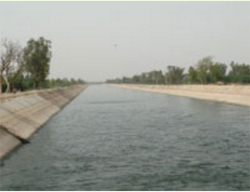 A pitcher irrigation technique has been developed to use saline water for vegetable cultivation
A pitcher irrigation technique has been developed to use saline water for vegetable cultivation -
Off-farm strategies based on lining, modification in operational schedules, auxiliary storage, groundwater marketing from head to tail ends have been recommended to improve system efficiencies, equity and reliability of water supplies (Photo bottom)
-
Methodologies to use GIS and remote sensing to assess crop productivity in irrigation commands under saline environment have been demonstrated
Multi-Enterprise Agriculture System
-
-
A multi-enterprise agriculture model is being developed for 2 ha reclaimed sodic land for crop diversification and to increase resource use efficiency of water, nutrients and energy besides providing regular income, employment and livelihood to farmers owing small farm holdings (Photo top)

-
Multi-enterprise agriculture has the potential to decrease cultivation cost by synergetic recycling of bi-products/residues of various components within the system
-
The project initiated in 2006 involves various capsules based on field crops, dairying, horticulture, floriculture, vegetables, fisheries, bee-keeping, duckery, poultry and mushroom production in an interdisciplinary approach (Photo bottom)
-
 Similar models are also being standardized for waterlogged sodic soils at RRS, Lucknow, highly saline black soils at RRS, Bharuch and coastal region at Canning Town
Similar models are also being standardized for waterlogged sodic soils at RRS, Lucknow, highly saline black soils at RRS, Bharuch and coastal region at Canning Town
-
|
Three years results indicated that net income of Rs. 300-400/day can be generated from this model upon practising these enterprizes in a unified farming system mode.
|
Resource Conservation Technologies
-
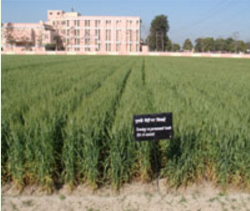 In the post-reclamation phase, the focus has shifted to precision farming and the adoption of low cost, energy saving technologies for enhancing rice-wheat productivity (Photo top)
In the post-reclamation phase, the focus has shifted to precision farming and the adoption of low cost, energy saving technologies for enhancing rice-wheat productivity (Photo top)
-
 rabi, maximum yield was recorded when wheat was sown by zero tillage and Sesbania co-culture as brown manuring in rice, followed by zero tillage without residue (Photo middle)
rabi, maximum yield was recorded when wheat was sown by zero tillage and Sesbania co-culture as brown manuring in rice, followed by zero tillage without residue (Photo middle)
-
During kharif, maximum rice yield was obtained in conventional transplanting without residue followed by direct seeded rice (DSR) without residue (Photo bottom)
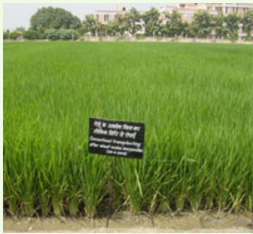
-
Highest water productivity was recorded in DSR followed by DSR with Sesbania co-culture. The maximum water saving was recorded in DSR at transplanting time (49%) followed by DSR+Sesbania (43%) and raised bed transplanted rice (24%).
|
CSISA (Cereal System Initiative for South Asia) – A collaborative project initiated with IRRI and CIMMYT to develop crop and resource management based practices for an innovative, intensive, and sustainable futuristic cereal based production system for the future.
|
Bio-Drainage
Bio-drainage for Land Reclamation
-
Biodrainage technology developed to prevent and reclaim waterlogged saline soils in canal command areas by raising Eucalyptus plantation on killa-line, in Baas and Puthi villages (Photo top)
-
 The five years old trees could lower the water table by 85 cm with an average transpiration rate of 50 litre day-1 plant-1
The five years old trees could lower the water table by 85 cm with an average transpiration rate of 50 litre day-1 plant-1 -
Farmers’ harvested good rice and wheat crops in such areas besides having 36 tones per ha-1 of total wood biomass. The plantation could sequester about 24 t ha-1 carbon during this period
Bio-drainage for Wastewater Disposal
-
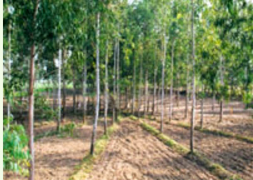 Large quantities of wastewater generated in peri-urban areas are being used indiscriminately as raw or with little treatment for irrigating food crops including vegetables with no concerns for contamination of natural resources and food chain
Large quantities of wastewater generated in peri-urban areas are being used indiscriminately as raw or with little treatment for irrigating food crops including vegetables with no concerns for contamination of natural resources and food chain -
Technologies developed for safe disposal of these waters for the cultivation of tree crops (Photo bottom), industrial crops, aromatic grasses or flower crops producing high biomass with non-edible economic parts as these do not form a part of the food chain
Alternate Uses of Saline Wastelands
-
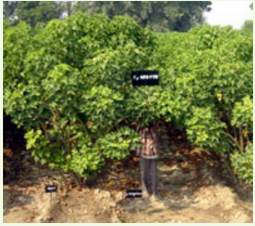 CSSRI has been trying to identify non-conventional crops that could adapt to utlize wastelands and provide income to the farmers. Plants that could be utilized for bio-fuel and bio-energy production were also evaluated
CSSRI has been trying to identify non-conventional crops that could adapt to utlize wastelands and provide income to the farmers. Plants that could be utilized for bio-fuel and bio-energy production were also evaluated -
Field and other studies showed good salt tolerance of Jatropha as not much reductions occurred at soil salinity of EC 10-12 dS m-1 and application of saline waters. The huge biomass produced is an added advantage of Jatropha cultivation (Photo top)
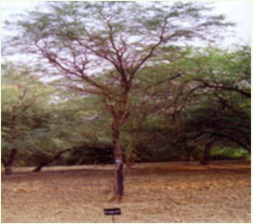
-
Potential of genus Prosopis was exploited as livelihood source in salt affected dry regions. Efforts were made for germplasm multiplication of promising species/clones for distribution to farmer/clients and standardized cultural practices for the cultivation of Prosopis in saline and alkali soils (Photo Middle)
-
Cactus has special significance in drought prone areas
of the country. Five clones have been introduced viz; 1270 (forage and fruit), 1271 (fruit),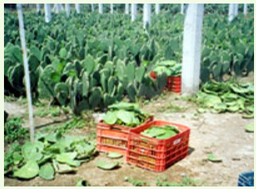 1280 (fruit), 1287 (fruit) and 1308 (vegetable). These clones have been characterized for sodicity tolerance and the agro-techniques for their cultivation have been standardized (photo bottom)
1280 (fruit), 1287 (fruit) and 1308 (vegetable). These clones have been characterized for sodicity tolerance and the agro-techniques for their cultivation have been standardized (photo bottom)
Wastewater Reuse and Bio-Remediation
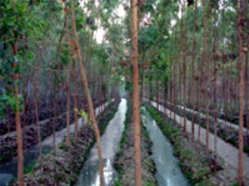 Current disposal alternatives have been documented and found ineffective and environmental by polluting. A package of practices has been developed to reuse domestic wastewaters for arable food and non-food crops. The nutrient potential of these wastewaters has also been documented (Photo top)
Current disposal alternatives have been documented and found ineffective and environmental by polluting. A package of practices has been developed to reuse domestic wastewaters for arable food and non-food crops. The nutrient potential of these wastewaters has also been documented (Photo top)Industrial Wastewaters
Entry of heavy metals in human beings and animals through food chain causes serious health hazards. Flower plants and oil seed crops that are hyper accumulators of some of the heavy metals have been identified
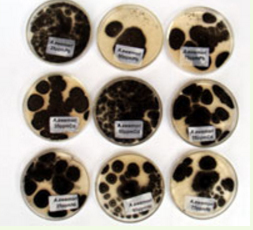 Bacteria and fungal isolates tolerant to 25 ppm of heavy metals like Cd, Cr, Pb, and Ni were isolated from samples of wastewater and sludge through enrichment technique. Majority of the microorganisms were able to tolerate heavy metals up to 400 ppm. These microbes could be utilized for bioremediation of industrial wastewater to remove heavy metals. Renewable biomass of microorganisms may be an environmentally friendly alternative than to costly physico-chemical processes to serve as bio-traps for removal of heavy metals (Photo bottom)
Bacteria and fungal isolates tolerant to 25 ppm of heavy metals like Cd, Cr, Pb, and Ni were isolated from samples of wastewater and sludge through enrichment technique. Majority of the microorganisms were able to tolerate heavy metals up to 400 ppm. These microbes could be utilized for bioremediation of industrial wastewater to remove heavy metals. Renewable biomass of microorganisms may be an environmentally friendly alternative than to costly physico-chemical processes to serve as bio-traps for removal of heavy metals (Photo bottom)
Artificial Groundwater Recharge
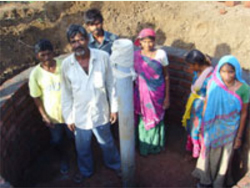 In North-Western States of the country like Punjab, Haryana and Uttar Pradesh, the sustainability of agriculture is threatened due to alarming decline in water table, increasing pumping costs and related environmental impacts (Photo top). Water decline rate varies from 0.2m/annum to more than 1m/annum with an average of about 0.6 m/annum
In North-Western States of the country like Punjab, Haryana and Uttar Pradesh, the sustainability of agriculture is threatened due to alarming decline in water table, increasing pumping costs and related environmental impacts (Photo top). Water decline rate varies from 0.2m/annum to more than 1m/annum with an average of about 0.6 m/annum
-
Potential of rice fields as groundwater recharge basin has been established.
 For semi-arid regions. Conventional height of dykes may be increased by 15-20 cm for conserving rainwater to minimize groundwater requirement for irrigation and additional recharge obviating the need for land required for water spreading (Photo middle)
For semi-arid regions. Conventional height of dykes may be increased by 15-20 cm for conserving rainwater to minimize groundwater requirement for irrigation and additional recharge obviating the need for land required for water spreading (Photo middle) -
To augment groundwater resources and improve water productivity per drop of water, recharge shafts and recharge cavities were installed at 70 sites in Haryana, Punjab, Gujarat and UP, which have raised groundwater levels and improved groundwater quality considerably
 The recharge structures (Photo bottom) so installed also act as a local surface drainage outlet to save crops from water stagnation
The recharge structures (Photo bottom) so installed also act as a local surface drainage outlet to save crops from water stagnation
Technologies from AICRP Centers
The 8 AICRP centers located in various agro-ecological settings act as outreach network centers of CSSRI  besides undertaking location specific studies to develop technologies for saline/sodic soils and use of poor quality waters.
besides undertaking location specific studies to develop technologies for saline/sodic soils and use of poor quality waters.
-
Generation of database on land and water quality for areas under their jurisdiction
-
Improved dorouv technology to skim fresh water floating on saline water for coastal regions developed
-
Bio-interceptor drainage studies carried out to control seepage
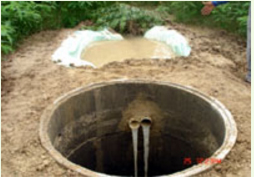
Raised and sunken bed technology to reclaim rain fed alkali vertisols developed (Photo top)
- In-situ
water conservation technologies for reclaiming rain fed alkali lands in Karnataka
-
Established potential of drip irrigation to use relatively poor saline water for vegetable cultivation
-
Established synergy of amendments and farm yard manure in enhancing yields while irrigating with sodic waters
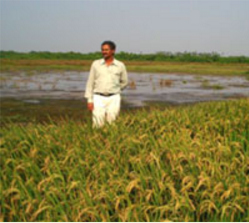
Groundwater recharge for aquifer dilution of poor quality groundwater during monsoon for use to diluted groundwater for first few irrigations to rabi crops (Photo middle)
-
Crop quality as affected by saline/sodic water irrigations for several vegetable crops have been conducted
-
Technology developed for reclamation of abandoned aqua ponds (Photo bottom)
Reclamation of Coastal Saline Soils
-
Salt affected vertisols cover an area of about 1.21 M ha in Gujarat alone. The problem also occurs in Karnataka, Maharashtra and Rajasthan. Swell-shrink character of these soils poses several problems in their reclamation

-
Due to high clay content, soils are adversely affected even at low salt concentration and exchangeable sodium
-
Technology has been developed and standardized for the cultivation of Salvadora on highly saline soils having ECe >40 dS m-1 (Photo top). Beside halophytic grasses have been identified for cultivation with highly saline water
 Cultivation of Dill, castor and sunflower with saline water irrigation has been developed (Photo middle)
Cultivation of Dill, castor and sunflower with saline water irrigation has been developed (Photo middle)
- These technologies have been adopted by the farmers, NGOs and Govt. Institutions like
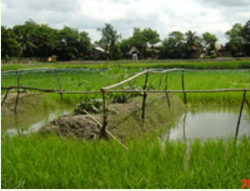 GSLDC on a large scale in Gujarat (Photo bottom)
GSLDC on a large scale in Gujarat (Photo bottom)
Reclamation of Salt Affected Vertisoils
-
Salt affected vertisols cover an area of about 1.21 M ha in Gujarat alone. The problem also occurs in Karnataka, Maharashtra and Rajasthan.
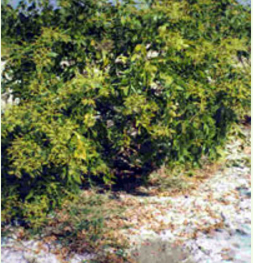 Swell-shrink character of these soils poses several problems in their reclamation
Swell-shrink character of these soils poses several problems in their reclamation -
Due to high clay content, soils are adversely affected even at low salt concentration and exchangeable sodium
-
Technology has been developed and standardized for the cultivation of Salvadora on highly saline soils having ECe >40 dS m-1 (Photo top). Beside halophytic grasses have been identified for cultivation with highly saline water
 Cultivation of Dill,
Cultivation of Dill,
castor and sunflower with saline water irrigation has been developed (Photo middle)
 These technologies have been adopted by the farmers, NGOs and Govt. Institutions like GSLDC on a large scale in Gujarat (Photo bottom)
These technologies have been adopted by the farmers, NGOs and Govt. Institutions like GSLDC on a large scale in Gujarat (Photo bottom)
|
NABARD has prepared a bankable model for promoting Salvadora cultivation in association with Institute’s regional research station at Bharuch.
|
Alkali Soils of Central and Eastern Gangetic Plains
-
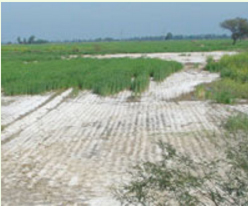 These alkali soils have distinct characteristics of surface drainage congestion, high water table conditions, relatively heavy textured soils with CaCO3 concretions at shallow depths. Synergy of salt tolerant rice and wheat varieties with chemical amendments has been exploited to reduce the need for chemical amendments by about half. The technology is now popularly known as bio-reclamation technology
These alkali soils have distinct characteristics of surface drainage congestion, high water table conditions, relatively heavy textured soils with CaCO3 concretions at shallow depths. Synergy of salt tolerant rice and wheat varieties with chemical amendments has been exploited to reduce the need for chemical amendments by about half. The technology is now popularly known as bio-reclamation technology -
Causes and remedial measures of resodification of reclaimed alkali soils revealed that shallow water table conditions (<2 m) was major parameter influencing resodification of reclaimed alkali soils (Photo top)
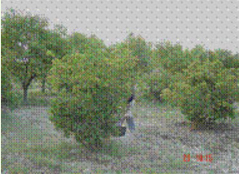 Agro-forestry/ silvi-pastoral/ horticultural fruit trees identified for practicing alternative land use systems are: forest tree species Prosopis juliflora followed by Casuarina equisetifolia and fruit trees such as Aonla (Emblica officinalis) and Karonda (Carissa carandas)( Photo middle)
Agro-forestry/ silvi-pastoral/ horticultural fruit trees identified for practicing alternative land use systems are: forest tree species Prosopis juliflora followed by Casuarina equisetifolia and fruit trees such as Aonla (Emblica officinalis) and Karonda (Carissa carandas)( Photo middle)
-
To address waterlogged sodic soils along
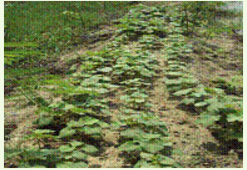 the Sharda Sahayak canal command area, a land reclamation model based on the concept of land modifications (physical land reclamation) and pond based integrated farming systems has been standardized (Photo bottom)
the Sharda Sahayak canal command area, a land reclamation model based on the concept of land modifications (physical land reclamation) and pond based integrated farming systems has been standardized (Photo bottom)


